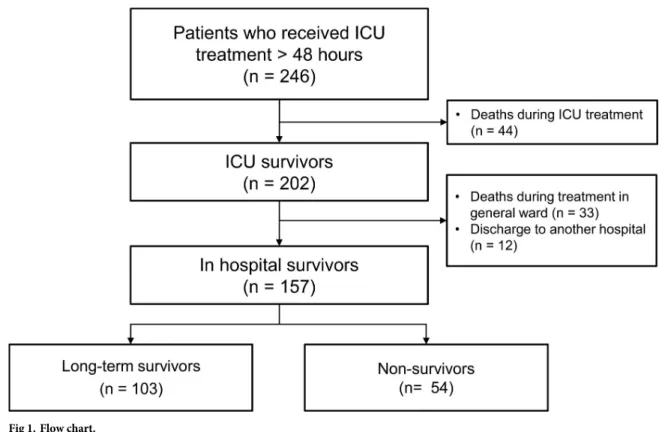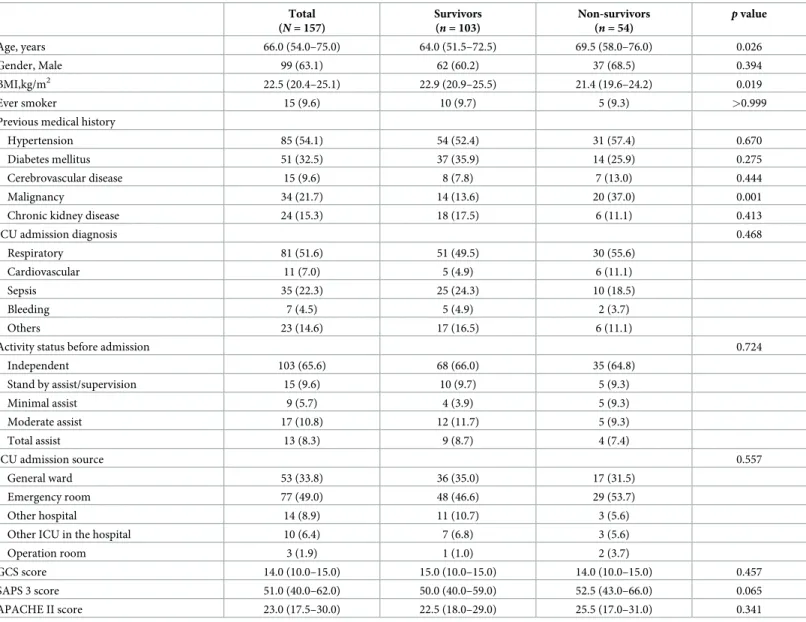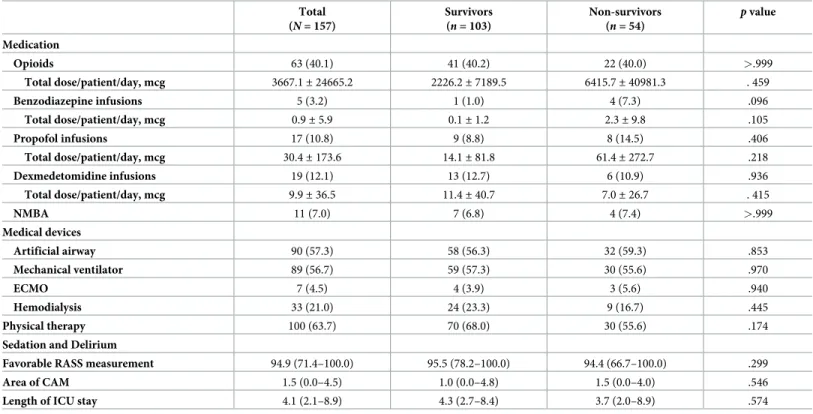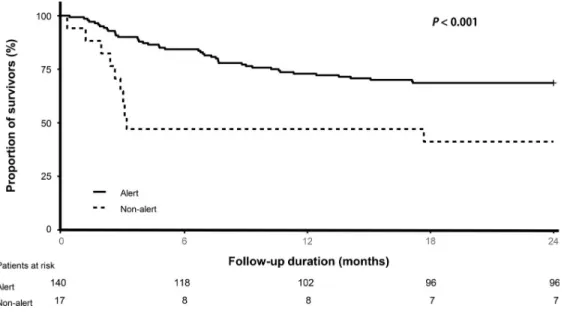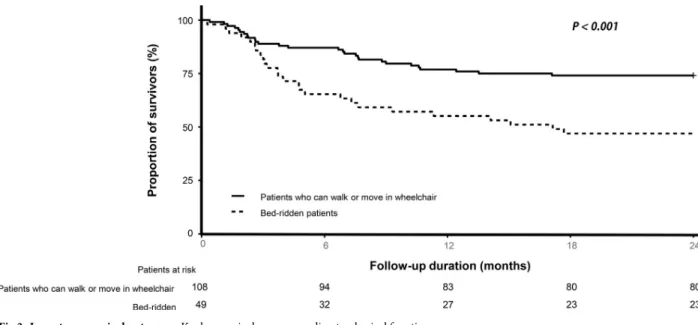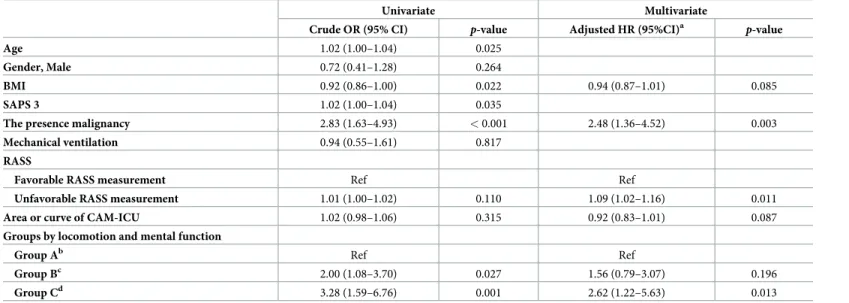Simple functional assessment at hospital
discharge can predict long-term outcomes of
ICU survivors
Ryoung-Eun Ko1☯, Hyun Lee2☯, Jin Hee Jung3, Hee Og Lee3, Insuk Sohn4, Heejin Yoo4, Jin Yeong Ko5, Gee Young Suh1,6, Chi Ryang ChungID1,7*
1 Department of Critical Care Medicine, Samsung Medical Center, Sungkyunkwan University School of Medicine, Seoul, South Korea, 2 Division of Pulmonary Medicine and Allergy, Department of Internal Medicine, Hanyang University College of Medicine, Seoul, South Korea, 3 Advanced Practice Nurse, Department of Nursing, Samsung Medical Center, Seoul, South Korea, 4 Statistics and Data Center, Samsung Medical Center, Seoul, South Korea, 5 Department of pharmaceutical services, Samsung Medical Center, Seoul, South Korea, 6 Division of Pulmonology and Critical Care Medicine, Department of Medicine, Samsung Medical Center, Sungkyunkwan University School of Medicine, Seoul, Korea, 7 Department of Medicine, Samsung Medical Center, Sungkyunkwan University School of Medicine, Seoul, Korea
☯These authors contributed equally to this work. *ccrzzang@gmail.com
Abstract
Recent studies showed that physical and/or neuropsychiatric impairments significantly affect long-term mortality of ICU survivors. We conducted this study to investigate that sim-plified measurement of physical function and level of consciousness at hospital discharge by attending nurses could predict long-term outcomes after hospital discharge. A retrospec-tive analysis of prospecretrospec-tively and retrospecretrospec-tively collected data of 246 patients who received medical ICU treatment was conducted. We grouped patients according to physical function and level of consciousness measured by the simplified method at hospital discharge as fol-low; group A included patients with alert mental and capable of walking or moving by wheel chairs; group B included those with alert mental and bed-ridden status; and Group C included those with confused mental and bed-ridden status. The two-year survival rate after hospital discharge was compared. Of 246 patients, 157 patients were included in the analy-sis and there were 103 survivors after two-year follow up. Compared to non-survivors, survi-vors were more likely to be younger (P = 0.026) and have higher body mass index (P = 0.019) and no malignant disease (P = 0.001). There were no statistically significant differ-ences in treatment modalities including medication, use of medical devices, and physical therapy between the survivors and non-survivors. The analysis showed significant differ-ences in survival between the groups classified by physical function (P<0.001) and level of consciousness (P<0.01). Multivariate analysis showed that survival rate was significantly lower among the patients in group C than in those in group B or group A (P<0.001). Simpli-fied method to assess physical function and level of consciousness at hospital discharge can predict long-term outcomes of medical ICU survivors.
a1111111111 a1111111111 a1111111111 a1111111111 a1111111111 OPEN ACCESS
Citation: Ko R-E, Lee H, Jung JH, Lee HO, Sohn I,
Yoo H, et al. (2019) Simple functional assessment at hospital discharge can predict long-term outcomes of ICU survivors. PLoS ONE 14(4): e0214602.https://doi.org/10.1371/journal. pone.0214602
Editor: Chiara Lazzeri, Azienda Ospedaliero
Universitaria Careggi, ITALY
Received: November 25, 2018 Accepted: March 17, 2019 Published: April 4, 2019
Copyright:© 2019 Ko et al. This is an open access article distributed under the terms of theCreative Commons Attribution License, which permits unrestricted use, distribution, and reproduction in any medium, provided the original author and source are credited.
Data Availability Statement: All relevant data are
within the paper and its Supporting Information files.
Funding: This research was supported by a grant
of the Korea Health Technology R&D Project through the Korea Health Industry Development Institute (KHIDI) (https://www.khidi.or.kr/eps), funded by the Ministry of Health & Welfare, Republic of Korea (grant number: HI14C0743 to CR Chung). The funders had no role in study
Introduction
Recent advances in intensive care unit (ICU) management have reduced the mortality of patients during ICU and hospital treatment [1,2]. Although in-hospital mortality has decreased, the long-term treatment outcomes of ICU survivors are still poor [3,4]. Thus, increasing interest has been shown in finding clinical factors that can predict the long-term mortality of ICU survivors [5,6].
ICU survivors often experience persistent physical and/or neuropsychiatric impairments, known together as post-intensive care syndrome [7–9]. Numerous studies have shown that these impairments are not only lasting but are also significantly associated with long-term prognosis [10–14]. Reflecting the importance of these factors on the long-term outcomes of ICU survivors, the National Institutes of Health NHLBI ARDS Network proposed the endo-typing method to advance understanding of post ICU care patients according to physical, cog-nitive, and mental health status by showing that decreased physical function with decreased mental health was related to poor long-term outcomes of ICU survivors [15]. However, despite the clinical relevance of this study, very complicated scales were applied that are time-consum-ing and need specialized teams of physical therapists or specialists, precludtime-consum-ing the potential use of the endotyping method in screening programs on patients in real-clinics.
Therefore, it is reasonable to suggest that a more convenient and simplified method could be performed during daily practice to predict the long-term mortality of ICU-survivors. In our institution, the physical function and level of consciousness of the patients are mandatorily evaluated by the attending nurses at hospital discharge. However, no previous study has attempted to evaluate whether this simplified functional assessment at hospital discharge can predict long-term morality of ICU-survivors. Using a prospective observational medical ICU patients data for quality improvement (QI) in nursing and retrospectively supplemented for analysis, we investigated whether simplified measurement of physical function and level of consciousness at hospital discharge by attending nurses could predict long-term outcomes after hospital discharge in medical ICU patients.
Materials and methods
Study patients
Data of 246 patients who were admitted to the medical ICU at the Samsung Medical Center (a 1961-bed, university-affiliated, tertiary referral hospital in Seoul, Korea) for at least 48 hours and recorded for QI in nursing between December 2013 and August 2014 was conducted. Of the 246 patients, 77 died before hospital discharge and 12 were excluded since they were admitted to another hospital at hospital discharge. Finally, 157 patients were included in this study (Fig 1).
Data collection
Data were prospectively collected for the quality improvement (QI) project of the ICU to improve the quality of the intensive care unit, and additional variables from the relevant data retrospectively collected through medical records.
Medical records were collected from each patient at three different stages: at the time of ICU admission, during ICU care, and at hospital discharge. At the time of ICU admission, data including age, gender, body mass index (BMI), smoking history, previous medical history, reason for admission to ICU, activity before admission, admission source (ward, emergency room, other ICU within hospital or outside hospital), and Simplified Acute Physiology Score (SAPS) 3 were evaluated. During ICU care, the medical data included the length of ICU stay,
design, data collection and analysis, decision to publish, or preparation of the manuscript.
Competing interests: The authors have declared
mobility, sedation scores, use of sedatives or analgesics, and use of artificial devices were evalu-ated. We further collected medical records including physical function and level of conscious-ness at hospital discharge.
Definitions
Long-term survival was analyzed based on mortality at two-years after hospital discharge. Dos-ages of opioids including fentanyl, morphine, hydromorphone, and remifentanil were con-verted to their fentanyl equivalent [16]. Dosages of benzodiazepines were described as midazolam dosage because we only used midazolam. To evaluate the physical function and level of consciousness at the time of hospital discharge, attending nurses prospectively assessed these factors at the time of hospital discharge, classified the patients into alert and non-alert (drowsy, stupor, and semi-coma) groups according to level of consciousness and groups who can walk, those who can move using a wheelchair, and bed-ridden groups according to loco-motion function. For analyses, patients were further classified into three groups according to the composite of physical function and level of consciousness as follows: Group A included patients who were alert and capable of walking or moving using a wheelchair; Group B included patients who were alert, but in bed-ridden status; and Group C included patients who were not alert and in bed-ridden status. Delirium was assessed three times a day using the Confusion Assessment Method-ICU (CAM-ICU) [17]. For analyses, we calculated the area under the curve (AUC) of CAM, which was defined as the area of the CAM value over time. Richmond Agitation-Sedation Scale (RASS) was used to estimate levels of sedation and agita-tion and were checked once daily [18]. Each RASS measurement was classified into favorable (-1, 0, 1) and unfavorable (-5, -4, -3, -2, 2, 3, 4) measurements. For analysis, the proportion of favorable RASS measurement over a total number of RASS measurements was calculated for each patient.
Fig 1. Flow chart.
Statistical analysis
Categorical variables were analyzed using the Pearsonχ2 test or Fisher exact test. Continuous variables were analyzed using the Mann-Whitney-Wilcoxon U test. Multivariate analysis using the Cox-regression model was used to evaluate whether the composite mental and perfor-mance status are significantly associated with long-term survival after hospital discharge. Ini-tial candidate variables were those at the time of ICU admissions (including age, sex, BMI, SAPS3, the presence of malignancy, use of mechanical ventilation, RASS, and CAM) and those at the time of hospital discharge (including the level of consciousness and functional status). Covariates with P < 0.2 in univariate analysis, a variance inflation factor of less than 4, and those clinically relevant were entered into the multivariate model. All tests were two-sided, and a P value of less than 0.05 was considered statistically significant. All analyses were per-formed using SPSS for Windows (ver. 24.0; IBM Corp., Armonk, NY, USA) and R version 3.2.3 (R Foundation for Statistical Computing, Vienna, Austria)
Ethics approval and consent to participate
This study was a retrospective observational study and the study protocol was approved by the institutional review board of the Samsung Medical Center to review and publish information obtained from patient records (IRB no. 2018-01-021-002). Informed consent was waived by the IRB due to the retrospective study design. All methods employed in this study were per-formed in accordance with the relevant guidelines and regulations.
Results
Baseline characteristics
The baseline characteristics of 157 patients are described inTable 1. Of the 157 patients, the median age was 66.0 years (interquartile range [IQR], 54.0–75.0 years) and 99 (63.1%) were men. The median BMI was 22.5 kg/m2(IQR, 20.4–25.1 kg/m2). Common previous medical histories were hypertension (n = 85, 54.1%), diabetes mellitus (n = 51, 32.5%), and malignancy (n = 34, 21.7%). The common causes of ICU admission were respiratory failure (n = 81, 51.6%) and sepsis (n = 35, 22.3%). Regarding physical activity before ICU admission, 103 patients (65.6%) were independent. Seventy-seven patients (49.0%) were admitted through the emergency room and 53 patients (33.8%) were referred from the general ward within the hos-pital. The median SAPS 3 score and the Acute Physiology and Chronic Health Evaluation II score (APACHE II) were 51.0 (IQR, 40.0–62.0) and 23.0 (IQR, 17.5–30.0), respectively.
Compared to survivors, non-survivors were more likely to be older (median 64.0 years [IQR, 51.5–72.5 years] vs. 69.5 years [IQR, 58.0–76.0 years];p = 0.026), have lower BMI (median 22.9 kg/m2(IQR, 20.9–25.5 kg/m2) vs. 21.4 kg/m2(IQR, 19.6–24.2 kg/m2);p = 0.019), and have malignancy as a comorbidity (37.0% [20/54] vs. 13.6% [14/103];p = 0.001). No signif-icant differences were observed in gender, smoking history, ICU admission diagnosis, activity status before admission, ICU admission source, SAPS 3, and APACHE II between the patients who survived and non-survived after 2-year of follow up.
Comparison of treatment modalities and sedation and delirium between
survivors and non-survivors
As shown inTable 2, no statistically significant differences were found in the treatment modal-ities including medication (opioids, benzodiazepine, propofol, dexmedetomidine, and neuro-muscular blocking agent), use of medical devices (artificial airway, home ventilator,
extra-corporeal membrane oxygenation, and hemodialysis), and physical therapy between the survi-vors and non-survisurvi-vors.
Comparison of mental and locomotion function at hospital discharge
between survivors and non-survivors
Regarding the level of consciousness at hospital discharge, survivors were more likely to be alert than non-survivors (93.2% [96/103] vs. 81.5% [44/54]). Regarding locomotion function at hospital discharge, non-survivors were more likely to be bed-ridden than survivors (48.1% [26/54] vs. 22.3% [23/103];p < 0.001).
Table 1. Baseline characteristics of study population.
Total (N = 157) Survivors (n = 103) Non-survivors (n = 54) p value Age, years 66.0 (54.0–75.0) 64.0 (51.5–72.5) 69.5 (58.0–76.0) 0.026 Gender, Male 99 (63.1) 62 (60.2) 37 (68.5) 0.394 BMI,kg/m2 22.5 (20.4–25.1) 22.9 (20.9–25.5) 21.4 (19.6–24.2) 0.019 Ever smoker 15 (9.6) 10 (9.7) 5 (9.3) >0.999
Previous medical history
Hypertension 85 (54.1) 54 (52.4) 31 (57.4) 0.670
Diabetes mellitus 51 (32.5) 37 (35.9) 14 (25.9) 0.275
Cerebrovascular disease 15 (9.6) 8 (7.8) 7 (13.0) 0.444
Malignancy 34 (21.7) 14 (13.6) 20 (37.0) 0.001
Chronic kidney disease 24 (15.3) 18 (17.5) 6 (11.1) 0.413
ICU admission diagnosis 0.468
Respiratory 81 (51.6) 51 (49.5) 30 (55.6)
Cardiovascular 11 (7.0) 5 (4.9) 6 (11.1)
Sepsis 35 (22.3) 25 (24.3) 10 (18.5)
Bleeding 7 (4.5) 5 (4.9) 2 (3.7)
Others 23 (14.6) 17 (16.5) 6 (11.1)
Activity status before admission 0.724
Independent 103 (65.6) 68 (66.0) 35 (64.8)
Stand by assist/supervision 15 (9.6) 10 (9.7) 5 (9.3)
Minimal assist 9 (5.7) 4 (3.9) 5 (9.3)
Moderate assist 17 (10.8) 12 (11.7) 5 (9.3)
Total assist 13 (8.3) 9 (8.7) 4 (7.4)
ICU admission source 0.557
General ward 53 (33.8) 36 (35.0) 17 (31.5)
Emergency room 77 (49.0) 48 (46.6) 29 (53.7)
Other hospital 14 (8.9) 11 (10.7) 3 (5.6)
Other ICU in the hospital 10 (6.4) 7 (6.8) 3 (5.6)
Operation room 3 (1.9) 1 (1.0) 2 (3.7)
GCS score 14.0 (10.0–15.0) 15.0 (10.0–15.0) 14.0 (10.0–15.0) 0.457 SAPS 3 score 51.0 (40.0–62.0) 50.0 (40.0–59.0) 52.5 (43.0–66.0) 0.065 APACHE II score 23.0 (17.5–30.0) 22.5 (18.0–29.0) 25.5 (17.0–31.0) 0.341
Data are presented as median (IQR) or number (%).
BMI, body mass index; GCS, Glasgow Coma Scale; SAPS 3, Simplified Acute Physiology Score 3; APACHE II score, Acute Physiology and Chronic Health Evaluation II score.
Kaplan-Meier analysis for 2-year survival according to mental and
locomotion function
The Kaplan-Meier plot showed significant differences in survival between the groups classified by level of consciousness (p < 0.01 for alert and non-alert groups,Fig 2) and locomotion func-tion (p < 0.001 for groups who can walk, those who can move using a wheelchair, and the bed-ridden group,Fig 3).
Clinical factors associated with survivors after 2-year follow up
In the univariate Cox proportional hazard regression analysis, age (hazard ratio [HR] = 1.02, p = 0.025), BMI (HR = 0.92, p = 0.022), SAPS 3 (HR = 1.02, HR = 0.022), the presence of malig-nancy (HR = 2.83,p < 0.001), groups according to the level of consciousness and locomotion function (group B [HR = 2.00,p = 0.027] and group C [HR = 3.28, p = 0.001] were factors asso-ciated with long-term mortality. In multivariate analyses, the presence of malignancy (adjusted HR = 2.48,p = 0.003), the proportion of unfavorable RASS measurement (adjusted HR = 1.09, p = 0.011), and group C (HR = 2.62, p = 0.013) were significantly associated with long-term mortality. As shown inFig 4, significant differences were shown in the adjusted survival curves for the Cox proportional hazard model between the groups (Table 3).
Discussion
In this study, the relationship between physical function and level of consciousness was evalu-ated at hospital discharge and subsequent long-term mortality. Our study showed that a simple
Table 2. Comparison of treatment modalities, and of sedation and delirium between the survivors and non-survivors. Total (N = 157) Survivors (n = 103) Non-survivors (n = 54) p value Medication Opioids 63 (40.1) 41 (40.2) 22 (40.0) >.999 Total dose/patient/day, mcg 3667.1± 24665.2 2226.2± 7189.5 6415.7± 40981.3 . 459 Benzodiazepine infusions 5 (3.2) 1 (1.0) 4 (7.3) .096 Total dose/patient/day, mcg 0.9± 5.9 0.1± 1.2 2.3± 9.8 .105 Propofol infusions 17 (10.8) 9 (8.8) 8 (14.5) .406 Total dose/patient/day, mcg 30.4± 173.6 14.1± 81.8 61.4± 272.7 .218 Dexmedetomidine infusions 19 (12.1) 13 (12.7) 6 (10.9) .936 Total dose/patient/day, mcg 9.9± 36.5 11.4± 40.7 7.0± 26.7 . 415 NMBA 11 (7.0) 7 (6.8) 4 (7.4) >.999 Medical devices Artificial airway 90 (57.3) 58 (56.3) 32 (59.3) .853 Mechanical ventilator 89 (56.7) 59 (57.3) 30 (55.6) .970 ECMO 7 (4.5) 4 (3.9) 3 (5.6) .940 Hemodialysis 33 (21.0) 24 (23.3) 9 (16.7) .445 Physical therapy 100 (63.7) 70 (68.0) 30 (55.6) .174
Sedation and Delirium
Favorable RASS measurement 94.9 (71.4–100.0) 95.5 (78.2–100.0) 94.4 (66.7–100.0) .299
Area of CAM 1.5 (0.0–4.5) 1.0 (0.0–4.8) 1.5 (0.0–4.0) .546
Length of ICU stay 4.1 (2.1–8.9) 4.3 (2.7–8.4) 3.7 (2.0–8.9) .574
Data are presented as median and IQR or number (%).
PT, physical therapy; RASS, Richmond Agitation-Sedation Scale; CAM-ICU, Confusion Assessment Method-ICU; NMBA, neuromuscular blocker agent; ECMO, extra-corporeal membrane oxygenation.
assessment of physical function or level of consciousness by attending nurses at hospital dis-charge can predict the long-term mortality of medical ICU survivors. Compared to the patients without physical or cognitive abnormality, those who had both decreased physical function and impaired consciousness had a greater incidence of long-term mortality. To the best of our knowledge, this is the first study showing the effectiveness of simple functional assessment on predicting long-term outcomes of medical ICU survivors.
In this study, during the two-year follow-up duration, about a third of the patients who had received critical care died after hospital discharge; this is consistent with the previous studies which revealed that the long-term survival rate of ICU survivors is still suboptimal [19–21]. Surprisingly, more than half of the ICU survivors had functional abnormalities associated with being incapable of unassisted walking, and more than 10% of ICU survivors had both impaired functional abnormalities and level of consciousness [4]. These results suggest that an aug-mented strategy to improve physical and mental health is urgently required to improve the long-term outcomes of ICU survivors.
Our study revealed that functional impairment at hospital discharge is an independent fac-tor for predicting long-term outcomes of ICU survivors. This finding is consistent with find-ings shown in previous studies that explored the association between physical or
neuropsychiatric functions and long-term prognosis in ICU survivors.
Extending the findings of previous studies, our study showed a combined effect of physical function and level of consciousness on long-term treatment outcomes of ICU survivors. Inter-estingly, after adjusting for confounding factors, the sole presence of physical impairment was not a solid criterion for discrimination between survivors and non-survivors. However, the additional presence of an impaired level of consciousness independently predicted the poor outcomes in ICU survivors. These results might suggest that clinicians need to pay more atten-tion to those subjects with physical impairments, but with intact consciousness since these fac-tors might be adjusted by active treatment such as rehabilitation. However, since we have no data regarding this issue, further studies are needed to confirm our suggestions.
Another strength of our study is the simple functional assessment performed by attending nurses. While various methods have been proposed of measuring physical and neuropsychiat-ric function that can accurately predict long-term treatment outcomes of ICU survivors [7,22],
Fig 2. Long-term survival outcomes. Kaplan survival curve according to the level of consciousness.
most of these have been calculated through complex formulas, which might not be applicable to most hospitals in real-world clinic since most ICUs suffer from insufficient medical resources, including medical staff [23,24]. Therefore, it is very difficult to apply these complex formulas in real clinical ICU. In this view, our results provide informative data whereby long-term mortality can be predicted by a simple assessment, measuring physical function accord-ing to locomotion function (such as the ability to walk or move usaccord-ing a wheelchair, and bed-ridden status) and level of consciousness (arousal or non-arousal). This approach might be more suitable to real-world ICU settings. And, the simple functional assessment is applicable to patient by not only nurses but also all medical staff. Therefore, it might be useful to set an easy and clear goal of discharge patients by every medical staff. Caregivers also can easily understand the long-term prognosis of the patient through easily understandable assessment method, so the physician can discuss the plan according to the patient’s progress and reduce unnecessary ICU re-admission.
Fig 3. Long-term survival outcomes. Kaplan survival curve according to physical function.
https://doi.org/10.1371/journal.pone.0214602.g003
Fig 4. Adjusted survival curve for the Cox proportional hazard model.
This study has several limitations. First, this study was conducted at a single center medical ICU in South Korea, and the simple assessment performed might therefore not be applicable to patients in other ICUs in other countries. Thus, further studies are needed to confirm our methods. Second, due to the observational design, our study might have inherent biases related to confounding, potential reverse causation, and the lack of a randomly distributed exposure. Third, we were unable to adjust for psychiatric variables, mental status and level of activity before admission that might have affected physical function and level of consciousness. Forth, only the history of cerebral vascular disease and GCS score at admission were included in the patient’s neurological baseline characteristics.
Conclusion
Our study showed that a simple assessment of physical function and level of consciousness at hospital discharge can predict long-term mortality of medical ICU survivors, which suggests the need for augmented treatment strategies to improve physical function and level of con-sciousness in ICU care. However, since this method has not been validated in other cohorts, a validation study is needed.
Supporting information
S1 Table. Comparison of mental and locomotion functions between survivors and non-survivors.
(DOCX)
S1 Dataset. PONE-D-18-33786R1_FTC_rawdata.csv.
(CSV)
Table 3. Clinical factors affecting long-term mortality in patients receiving ICU treatment.
Univariate Multivariate
Crude OR (95% CI) p-value Adjusted HR (95%CI)a
p-value
Age 1.02 (1.00–1.04) 0.025
Gender, Male 0.72 (0.41–1.28) 0.264
BMI 0.92 (0.86–1.00) 0.022 0.94 (0.87–1.01) 0.085
SAPS 3 1.02 (1.00–1.04) 0.035
The presence malignancy 2.83 (1.63–4.93) < 0.001 2.48 (1.36–4.52) 0.003
Mechanical ventilation 0.94 (0.55–1.61) 0.817
RASS
Favorable RASS measurement Ref Ref
Unfavorable RASS measurement 1.01 (1.00–1.02) 0.110 1.09 (1.02–1.16) 0.011
Area or curve of CAM-ICU 1.02 (0.98–1.06) 0.315 0.92 (0.83–1.01) 0.087
Groups by locomotion and mental function
Group Ab Ref Ref
Group Bc 2.00 (1.08–3.70) 0.027 1.56 (0.79–3.07) 0.196
Group Cd 3.28 (1.59–6.76) 0.001 2.62 (1.22–5.63) 0.013
BMI, body mass index; SAPS 3, Simplified Acute Physiology Score 3; CAM-ICU, Confusion Assessment Method-ICU.
a
Adjusted for gender, age, factors with ap < 0.2 (BMI, SAPS3, previous malignancy, group), and mechanical ventilator, RASS, area of CAM-ICU as clinically relevant.
b
Group A included patients with alert mental status who were able to walk or move using a wheelchair.
c
Group B included patients with alert mental status but were bedridden.
d
Group C included patients with non-alert mental status and bedridden.
Acknowledgments
The authors thank the Samsung Medical Center ICU rehabilitation team and the staff of the medical ICU for their enthusiasm and commitment to patient care.
Author Contributions
Data curation: Ryoung-Eun Ko, Jin Hee Jung, Hee Og Lee, Jin Yeong Ko. Formal analysis: Ryoung-Eun Ko, Hyun Lee, Insuk Sohn, Heejin Yoo. Funding acquisition: Chi Ryang Chung.
Investigation: Ryoung-Eun Ko, Gee Young Suh. Methodology: Hyun Lee, Gee Young Suh. Supervision: Gee Young Suh, Chi Ryang Chung. Writing – original draft: Ryoung-Eun Ko.
Writing – review & editing: Hyun Lee, Chi Ryang Chung.
References
1. Zambon M, Vincent JL. Mortality rates for patients with acute lung injury/ARDS have decreased over time. Chest. 2008; 133:1120–7.https://doi.org/10.1378/chest.07-2134PMID:18263687
2. Erickson SE, Martin GS, Davis JL, Matthay MA, Eisner MD, Network NNA. Recent trends in acute lung injury mortality: 1996–2005. Crit Care Med. 2009; 37:1574–9.https://doi.org/10.1097/CCM.
0b013e31819fefdfPMID:19325464
3. Stevens RD, Hart N, Herridge MS. Textbook of Post-ICU Medicine, The Legacy of Critical Care. Oxford: Oxford University Press; 2014.
4. Hashem MD, Nallagangula A, Nalamalapu S, Nunna K, Nausran U, Robinson KA, et al. Patient out-comes after critical illness: a systematic review of qualitative studies following hospital discharge. Crit Care. 2016; 20:345.https://doi.org/10.1186/s13054-016-1516-xPMID:27782830
5. Tipping CJ, Harrold M, Holland A, Romero L, Nisbet T, Hodgson CL. The effects of active mobilisation and rehabilitation in ICU on mortality and function: a systematic review. Intensive Care Med. 2017; 43:171–83.https://doi.org/10.1007/s00134-016-4612-0PMID:27864615
6. Parry SM, Knight LD, Connolly B, Baldwin C, Puthucheary Z, Morris P, et al. Factors influencing physi-cal activity and rehabilitation in survivors of critiphysi-cal illness: a systematic review of quantitative and quali-tative studies. Intensive Care Med. 2017; 43:531–42.https://doi.org/10.1007/s00134-017-4685-4
PMID:28210771
7. Herridge MS, Tansey CM, Matte A, Tomlinson G, Diaz-Granados N, Cooper A, et al. Functional disabil-ity 5 years after acute respiratory distress syndrome. N Engl J Med. 2011; 364:1293–304.https://doi. org/10.1056/NEJMoa1011802PMID:21470008
8. Dowdy DW, Eid MP, Sedrakyan A, Mendez-Tellez PA, Pronovost PJ, Herridge MS, et al. Quality of life in adult survivors of critical illness: a systematic review of the literature. Intensive Care Med. 2005; 31:611–20.https://doi.org/10.1007/s00134-005-2592-6PMID:15803303
9. Desai SV, Law TJ, Needham DM. Long-term complications of critical care. Crit Care Med. 2011; 39:371–9.https://doi.org/10.1097/CCM.0b013e3181fd66e5PMID:20959786
10. Rydingsward JE, Horkan CM, Mogensen KM, Quraishi SA, Amrein K, Christopher KB. Functional Sta-tus in ICU Survivors and Out of Hospital Outcomes: A Cohort Study. Crit Care Med. 2016; 44:869–79.
https://doi.org/10.1097/CCM.0000000000001627PMID:26929191
11. Neumeier A, Nordon-Craft A, Malone D, Schenkman M, Clark B, Moss M. Prolonged acute care and post-acute care admission and recovery of physical function in survivors of acute respiratory failure: a secondary analysis of a randomized controlled trial. Crit Care. 2017; 21:190.https://doi.org/10.1186/ s13054-017-1791-1PMID:28732512
12. Honselmann KC, Buthut F, Heuwer B, Karadag S, Sayk F, Kurowski V, et al. Long-term mortality and quality of life in intensive care patients treated for pneumonia and/or sepsis: Predictors of mortality and quality of life in patients with sepsis/pneumonia. J Crit Care. 2015; 30:721–6.https://doi.org/10.1016/j. jcrc.2015.03.009PMID:25818842
13. Mitchell ML, Shum DHK, Mihala G, Murfield JE, Aitken LM. Long-term cognitive impairment and delir-ium in intensive care: A prospective cohort study. Aust Crit Care. 2018; 31:204–11.https://doi.org/10. 1016/j.aucc.2017.07.002PMID:28736089
14. Baldwin MR, Reid MC, Westlake AA, Rowe JW, Granieri EC, Wunsch H, et al. The feasibility of measur-ing frailty to predict disability and mortality in older medical intensive care unit survivors. J Crit Care. 2014; 29:401–8.https://doi.org/10.1016/j.jcrc.2013.12.019PMID:24559575
15. Brown SM, Wilson EL, Presson AP, Dinglas VD, Greene T, Hopkins RO, et al. Understanding patient outcomes after acute respiratory distress syndrome: identifying subtypes of physical, cognitive and mental health outcomes. Thorax. 2017; 72:1094–103.https://doi.org/10.1136/thoraxjnl-2017-210337
PMID:28778920
16. Principles of analgesic use in the treatment of acute pain and chronic cancer pain, 2nd edition. Ameri-can Pain Society. Clin Pharm. 1990; 9:601–12. PMID:2201478
17. Ely EW, Margolin R, Francis J, May L, Truman B, Dittus R, et al. Evaluation of delirium in critically ill patients: validation of the Confusion Assessment Method for the Intensive Care Unit (CAM-ICU). Crit Care Med. 2001; 29:1370–9. PMID:11445689
18. Ely EW, Truman B, Shintani A, Thomason JW, Wheeler AP, Gordon S, et al. Monitoring sedation status over time in ICU patients: reliability and validity of the Richmond Agitation-Sedation Scale (RASS). JAMA. 2003; 289:2983–91.https://doi.org/10.1001/jama.289.22.2983PMID:12799407
19. Brinkman S, de Jonge E, Abu-Hanna A, Arbous MS, de Lange DW, de Keizer NF. Mortality after hospi-tal discharge in ICU patients. Crit Care Med. 2013; 41:1229–36.https://doi.org/10.1097/CCM. 0b013e31827ca4e1PMID:23591209
20. Wunsch H, Guerra C, Barnato AE, Angus DC, Li G, Linde-Zwirble WT. Three-year outcomes for Medi-care beneficiaries who survive intensive Medi-care. JAMA. 2010; 303:849–56.https://doi.org/10.1001/jama. 2010.216PMID:20197531
21. Winters BD, Eberlein M, Leung J, Needham DM, Pronovost PJ, Sevransky JE. Long-term mortality and quality of life in sepsis: a systematic review. Crit Care Med. 2010; 38:1276–83.https://doi.org/10.1097/ CCM.0b013e3181d8cc1dPMID:20308885
22. Hopkins RO, Weaver LK, Collingridge D, Parkinson RB, Chan KJ, Orme JF Jr. Two-year cognitive, emotional, and quality-of-life outcomes in acute respiratory distress syndrome. Am J Respir Crit Care Med. 2005; 171:340–7.https://doi.org/10.1164/rccm.200406-763OCPMID:15542793
23. Lee H, Ko YJ, Suh GY, Yang JH, Park CM, Jeon K, et al. Safety profile and feasibility of early physical therapy and mobility for critically ill patients in the medical intensive care unit: Beginning experiences in Korea. J Crit Care. 2015; 30:673–7.https://doi.org/10.1016/j.jcrc.2015.04.012PMID:25957499
24. Du B, Xi X, Chen D, Peng J, China Critical Care Clinical Trial G. Clinical review: critical care medicine in mainland China. Crit Care. 2010; 14:206.https://doi.org/10.1186/cc8222PMID:20236446
